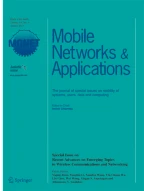Abstract
Our research focuses on enabling users to interact with others using 3D avatars with the same appearance and personality in different media such as the Internet, SMS or television and using different devices such as PCs, MACs, PDAs, mobile phones and televisions. This work’s main contribution is its use of a unique architecture, tested with a contact application, which is compatible with different media. The avatar appearance editor, the animation engine and the 3D models are the same for the different media: TV, SMS and Internet chat.
Similar content being viewed by others
References
Aizpurua; I., Ortiz, A., Oyarzun, D., Arizkuren, I., Posada, J. and Andrés, A.C. Adaptation of mesh morphing techniques for multilingual avatars used in web applications. Third International Workshop on Articulated Motion and Deformable Objects, Palma de Mallorca, Spain, September 2004
Alexa M, Behr J, Mäuler W (2000) The morph node. Proceedings Web 3D/WRML, pp 29–34, Monterrey
Amin AK, Kersten BTA, Kulyk OA, Pelgrim PH, Wang CM, Markopoulos P (2005) SenseMS: a user-centered approach to enrich the messaging experience for teens by non-verbal means. Proceedings of the 7th international conference on Human computer interaction with mobile devices & services, pp 161–166, Salzburg, Austria
Berner U, Rieger TA (2002) Scalable avatar for conversational user interfaces. User Interfaces for All, Paris
Coppens T, Trappeniers L, Godon M (2004) AmigoTV: towards a social TV experience. Proceedings from the Second European Conference on Interactive Television “Enhancing the experience”, University of Brighton
Gâteau B, Khadraoui D (2006) Arbitration of autonomous multimedia objects with a multi-agent system. Inf Commun Technol ICTTA’06 2:3007–3012
Khadraoui M, Hirsbruner B, MeinKohn F, Khadraoui D, Courant M (2005) Interactive TV show based on avatars. 2005 systems communications (ICW’05, ICHSN’05, ICMCS’05, SENET'05), pp 192–197
Ma C, Osherenko A, Prendinger H, Ishiizuka MA (2005) Chat system based on emotion estimation from text and embodied conversational messengers. Active Media Technology, 2005. (ATM 2005) Proceedings of the 2005 International Conference, May 19–21, pp 546–548
Maad S (2003) MARILYN: a novel platform for intelligent interactive TV (IITV). Proceedings of Human Computer Interaction International HCII2003 Conference, Crete, Greece, July 2003
Mochizuki Y, Senda K, Orimoto K, Tagawa J, Asahara S (2004) Humanoid agent for communication and entertainment driven by emotion and “Kansei” in embedded system. Consumer Communications and Networking Conference, pp 551–556
Mosmondor M, Kosutic T, Pandzic L (2005) LiveMail: personalized avatars for mobile entertainment. Proceedings of the Third International Conference on Mobile Systems, Applications, and Services, June 2005.
Persson P (2003) ExMS: a field study of expressive mobile messaging with avatar-based animations. Proceeding of CHI 2003 (CHI ‘03)
Tobita H, Rekimoto J (2004) Flat3D: a shared virtual 3D world grown by creative activities and communication through the network. Proceedings Computer Graphics International, pp 476–479
Marriott A, Beard S, Stallo J, Huynh Q (2001) VHML—directing a talking head. Proceedings of the 6th International Computer Science Conference on Active Media Technology, pp 90–100, December 18–20
Vilhjálmsson H, Cassell J (1998) Bodychat: autonomous communicative behaviors in avatars. International Conference on Autonomous Agents. Proceedings of the Second International Conference on Autonomous Agents, Minneapolis, MN, USA, pp 269–276
Acknowledgment
One author was partially supported by the Spanish Ministry of Education and Science (MEC) grant TIN2006-14968-C02-01.
Author information
Authors and Affiliations
Corresponding author
Rights and permissions
About this article
Cite this article
Carretero, M.d.P., Oyarzun, D., Ortiz, A. et al. Preserving Avatar Genuineness in Different Display Media. Mobile Netw Appl 13, 627–634 (2008). https://doi.org/10.1007/s11036-008-0094-9
Received:
Accepted:
Published:
Issue Date:
DOI: https://doi.org/10.1007/s11036-008-0094-9
